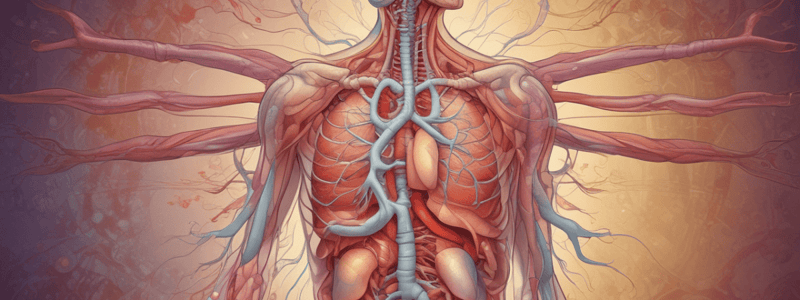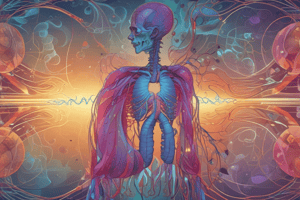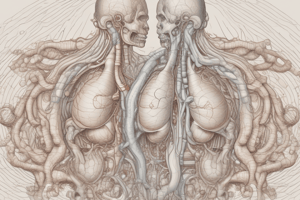Podcast
Questions and Answers
What determines gas transfer between different phases?
What determines gas transfer between different phases?
- Concentration gradient (ml/l or mmol/l)
- Partial pressure gradient (correct)
- Surface area of alveolar-capillary membrane
- Temperature difference
Why does CO2 equilibrate rapidly across the alveolar-capillary exchange surface?
Why does CO2 equilibrate rapidly across the alveolar-capillary exchange surface?
- Due to the larger surface area of the alveolar-capillary membrane
- Due to its lower molecular weight
- Due to its lower partial pressure gradient
- Due to its higher solubility coefficient in plasma (correct)
What happens to the partial pressure of O2 in the pulmonary capillary blood at rest?
What happens to the partial pressure of O2 in the pulmonary capillary blood at rest?
- It decreases along the length of the pulmonary capillary
- It increases along the length of the pulmonary capillary
- It equals the alveolar PO2 by about 1/3rd of the way along the pulmonary capillary (correct)
- It remains constant along the length of the pulmonary capillary
What is the consequence of an disrupted alveolar-capillary unit in respiratory disease?
What is the consequence of an disrupted alveolar-capillary unit in respiratory disease?
Why does CO2 diffuse more rapidly than O2 despite its higher molecular weight?
Why does CO2 diffuse more rapidly than O2 despite its higher molecular weight?
What is the direction of CO2 movement in the alveolar-capillary exchange surface?
What is the direction of CO2 movement in the alveolar-capillary exchange surface?
What is the characteristic of gas transfer in a normal lung?
What is the characteristic of gas transfer in a normal lung?
What is the relationship between the diffusion rates of O2 and CO2?
What is the relationship between the diffusion rates of O2 and CO2?
What is the unit of pressure equivalent to 7.5 mmHg?
What is the unit of pressure equivalent to 7.5 mmHg?
What is the rate of transfer of gas through a sheet of tissue dependent on?
What is the rate of transfer of gas through a sheet of tissue dependent on?
What is the pressure gradient driving diffusion across the alveolar-capillary membrane?
What is the pressure gradient driving diffusion across the alveolar-capillary membrane?
What does the diffusing capacity of the lungs (DLg) represent?
What does the diffusing capacity of the lungs (DLg) represent?
What is the formula to calculate oxygen diffusing capacity (DLO2)?
What is the formula to calculate oxygen diffusing capacity (DLO2)?
Why can mean pulmonary capillary PCO be assumed to be zero in the measurement of carbon monoxide diffusing capacity (DLCO)?
Why can mean pulmonary capillary PCO be assumed to be zero in the measurement of carbon monoxide diffusing capacity (DLCO)?
What is the advantage of using carbon monoxide in the measurement of diffusing capacity?
What is the advantage of using carbon monoxide in the measurement of diffusing capacity?
What is the purpose of including a tracer gas in the breath inhaled by the patient during the measurement of DLCO?
What is the purpose of including a tracer gas in the breath inhaled by the patient during the measurement of DLCO?
What is the effect of an acute ascent to altitude on the oxygen capacity of arterial blood?
What is the effect of an acute ascent to altitude on the oxygen capacity of arterial blood?
What is the effect of a decrease in pH on the oxygen-haemoglobin dissociation curve?
What is the effect of a decrease in pH on the oxygen-haemoglobin dissociation curve?
What is the effect of an increase in 2,3-DPG on the oxygen-haemoglobin dissociation curve?
What is the effect of an increase in 2,3-DPG on the oxygen-haemoglobin dissociation curve?
What is the effect of anaemia on the oxygen capacity of arterial blood?
What is the effect of anaemia on the oxygen capacity of arterial blood?
What is the PO2 at the base camp of Mt Aconcagua, given a barometric pressure of 60kPa?
What is the PO2 at the base camp of Mt Aconcagua, given a barometric pressure of 60kPa?
What is the effect of an increase in temperature on the oxygen-haemoglobin dissociation curve?
What is the effect of an increase in temperature on the oxygen-haemoglobin dissociation curve?
What is the effect of an increase in PCO2 on the oxygen-haemoglobin dissociation curve?
What is the effect of an increase in PCO2 on the oxygen-haemoglobin dissociation curve?
What is the oxygen saturation level of resting mixed venous blood?
What is the oxygen saturation level of resting mixed venous blood?
What is the primary reason for reduced arterial oxygen content in iron deficiency anemia?
What is the primary reason for reduced arterial oxygen content in iron deficiency anemia?
At high altitude, what is the primary reason for improved physical activity after breathing 100% oxygen for short periods?
At high altitude, what is the primary reason for improved physical activity after breathing 100% oxygen for short periods?
What is the approximate fraction of oxygen in dry air at sea level?
What is the approximate fraction of oxygen in dry air at sea level?
What is the term for the rate at which oxygen diffuses through the alveolar-capillary membrane?
What is the term for the rate at which oxygen diffuses through the alveolar-capillary membrane?
Why can CO transfer factor be measured but O2 transfer factor cannot?
Why can CO transfer factor be measured but O2 transfer factor cannot?
What would be the approximate partial pressure of oxygen on a mountain where the barometric pressure is 50.5 kPa (380 mmHg)?
What would be the approximate partial pressure of oxygen on a mountain where the barometric pressure is 50.5 kPa (380 mmHg)?
Which of the following would NOT cause a low CO transfer factor?
Which of the following would NOT cause a low CO transfer factor?
What would be the primary effect of hypoventilation on gas exchange in the lungs?
What would be the primary effect of hypoventilation on gas exchange in the lungs?
What is the effect of polycythaemia on the oxygen reservoir in severe chronic respiratory failure?
What is the effect of polycythaemia on the oxygen reservoir in severe chronic respiratory failure?
In severe chronic respiratory failure, why is the patient vulnerable to a small further fall in arterial PO2?
In severe chronic respiratory failure, why is the patient vulnerable to a small further fall in arterial PO2?
What is the effect of anaemia on average tissue capillary PO2 compared to a person with a normal Hb concentration?
What is the effect of anaemia on average tissue capillary PO2 compared to a person with a normal Hb concentration?
Why is the fall in PO2 along the tissue capillary less steep in polycythaemia?
Why is the fall in PO2 along the tissue capillary less steep in polycythaemia?
What is the consequence of a small further fall in arterial PO2 in a patient with severe chronic respiratory failure?
What is the consequence of a small further fall in arterial PO2 in a patient with severe chronic respiratory failure?
Why is the patient in severe chronic respiratory failure still vulnerable despite having adequate O2 delivery?
Why is the patient in severe chronic respiratory failure still vulnerable despite having adequate O2 delivery?
What is the relationship between the average tissue capillary PO2 and the venous PO2 in severe chronic respiratory failure?
What is the relationship between the average tissue capillary PO2 and the venous PO2 in severe chronic respiratory failure?
What is the effect of polycythaemia on the PO2 gradient driving diffusion in severe chronic respiratory failure?
What is the effect of polycythaemia on the PO2 gradient driving diffusion in severe chronic respiratory failure?
Flashcards are hidden until you start studying
Study Notes
Gas Exchange and Transport
- Diffusion of O2 and CO2 across the alveolar-capillary membrane is driven by partial pressure gradients.
- O2 diffuses from the alveoli into the pulmonary capillaries, while CO2 diffuses from the pulmonary capillaries into the alveoli.
- The rate of diffusion is affected by the partial pressure gradient, solubility coefficient, and molecular weight.
- CO2 has a higher solubility coefficient than O2, making it 23 times more soluble and allowing it to diffuse 20 times faster.
Factors Affecting Diffusion
- Partial pressure gradient: gas moves down its partial pressure gradient from high to low.
- Area and thickness of the alveolar-capillary membrane: increased surface area and decreased thickness facilitate diffusion.
- Solubility coefficient: gases with higher solubility coefficients diffuse faster.
Measurement of Diffusing Capacity
- Oxygen diffusing capacity (DLO2): measures the rate of O2 transfer from the alveoli to the pulmonary capillaries.
- Carbon monoxide diffusing capacity (DLCO): measures the rate of CO transfer from the alveoli to the pulmonary capillaries.
- DLCO is commonly used in clinical investigations to assess lung function.
Oxygen-Haemoglobin Dissociation Curve
- The curve shows the relationship between oxygen saturation and partial pressure.
- Factors affecting the curve include pH, PCO2, temperature, and 2,3-DPG levels.
Acute Ascent to Altitude
- Arterial oxygen content and saturation decrease due to decreased inspired PO2.
- Oxygen capacity of arterial blood is normal, but oxygen-carrying capacity is reduced.
Anaemia
- Oxygen capacity of arterial blood is reduced due to low haemoglobin levels.
- Arterial oxygen content and saturation are reduced due to decreased oxygen-carrying capacity.
Gaseous Diffusion and Transport Quiz
- Questions to consider:
- What factors affect water vapour pressure in the air we breathe?
- How do changes in barometric pressure affect PO2 and fractional concentration of oxygen in dry air?
- What is meant by "transfer factor" of a gas in the lungs?
- Why can CO transfer factor be measured but O2 transfer factor cannot?
- What causes a low CO transfer factor?
Studying That Suits You
Use AI to generate personalized quizzes and flashcards to suit your learning preferences.




